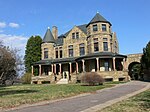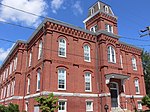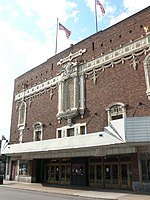Byrd Park Court Historic District
Buildings and structures in Richmond, VirginiaHistoric districts on the National Register of Historic Places in VirginiaMission Revival architecture in VirginiaNRHP infobox with nocatNational Register of Historic Places in Richmond, Virginia ... and 2 more
Richmond, Virginia Registered Historic Place stubsUse mdy dates from August 2023

The Byrd Park Court Historic District encompasses a small, well-preserved residential subdivision in western Richmond, Virginia. Located just east of William Byrd Park, nearly opposite the Swan Lake Drive entrance, stands Byrd Park Court, a loop road on which are set six duplexes and six single-family houses. A stone gate flanks the entrance, and the center of the loop has a grassy area with a water fountain. The houses were built in the 1920s, in a variety of period revival styles with Craftsman touches.The district was added to the National Register of Historic Places in 2016.
Excerpt from the Wikipedia article Byrd Park Court Historic District (License: CC BY-SA 3.0, Authors, Images).Byrd Park Court Historic District
Lake Road, Richmond Randolph
Geographical coordinates (GPS) Address Nearby Places Show on map
Geographical coordinates (GPS)
| Latitude | Longitude |
|---|---|
| N 37.543611111111 ° | E -77.471388888889 ° |
Address
Lake Road 733
23220 Richmond, Randolph
Virginia, United States
Open on Google Maps










